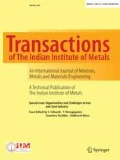Abstract
Additive manufacturing (AM) offers an efficient way of building complicated geometry in a shorter and cost-effective manner. Though process parameters could be optimised to decrease dimensional deviation of fused deposition modelling (FDM) manufactured components, getting acceptable dimensional accuracy from FDM remains a challenge compared to other AM processes. In this study, a geometric benchmark part was designed based on the NIST (National Institute of Standards and Technology) which comprises different geometrical features, and it was fabricated by varying process parameters on an FDM machine. Dimensions of these features on a fabricated benchmark component were determined using the coordinate measuring machine, and the machine learning (ML) approach was employed to predict the dimensions and deviation. ML models built (linear regression, LASSO, Ridge, random forest, XGBoost) based on the measured dimensions were able to predict the geometrical dimensions (length, width, height, diameter, thin walls/ slots, angle) and dimensional deviation without fabricating the components.




Similar content being viewed by others
References
I. Gibson, D. Rosen, B. Stucker, and M. Khorasani, “Additive Manufacturing Technologies.”
T. D. Ngo, A. Kashani, G. Imbalzano, K. T. Q. Nguyen, and D. Hui Composites Part B: Engineering, vol. 143. Elsevier Ltd, p. 172, Jun. 15, 2018. https://doi.org/10.1016/j.compositesb.2018.02.012.
A. Dey and N. Yodo, “A Systematic Survey of FDM Process Parameter Optimization and Their Influence on Part Characteristics,” J. Manuf. Mater. Process., vol. 3, no. 3, p. 64, Jul. 2019, https://doi.org/10.3390/jmmp3030064.
S. Mahmood, A. J. Qureshi, and D. Talamona, “Taguchi based process optimization for dimension and tolerance control for fused deposition modelling,” Addit. Manuf., vol. 21, pp. 183–190, May 2018, https://doi.org/10.1016/j.addma.2018.03.009.
M. Mahesh, Y. S. Wong, J. Y. H. Fuh, and H. T. Loh, Rapid Prototyping Journal, vol. 10, no. 2. Emerald Group Publishing Ltd., p. 123, 2004. https://doi.org/10.1108/13552540410526999.
M. Moshiri, S. Candeo, S. Carmignato, S. Mohanty, and G. Tosello, J. Manuf. Mater. Process., vol. 3, Dec. 2019, https://doi.org/10.3390/jmmp3040085.
A. Gregorian, B. Elliott, R. Navarro, F.Ochoa, H. Singh, E. Monge, J. Foyos, R. Noorani, B. Fritz, and S. Jayanthi, “ACCURACY IMPROVEMENT IN RAPID PROTOTYPING MACHINE (FDM-1650).”
T. Wuest, D. Weimer, C. Irgens, and K. D. Thoben, “Machine learning in manufacturing: Advantages, challenges, and applications,” Prod. Manuf. Res., vol. 4, no. 1, pp. 23–45, 2016, https://doi.org/10.1080/21693277.2016.1192517.
S. S. Razvi, S. Feng, A. Narayanan, Y. T. T. Lee, and P. Witherell, Proc. ASME Des. Eng. Tech. Conf., vol. 1, no. August, 2019, https://doi.org/10.1115/DETC2019-98415.
S. Moylan, J. Slotwinski, A. Cooke, K. Jurrens, and M. Alkan Donmez, “PROPOSAL FOR A STANDARDIZED TEST ARTIFACT FOR ADDITIVE MANUFACTURING MACHINES AND PROCESSES.” [Online]. Available: http://www.nist.gov/el/isd/sbm/matstandaddmanu.cfm;
A. . Lalitha.R, Prithvirajan.R, Rupalin Biswal, Atul Gir Goswami, “Lalitha-radhakrishnan/Predict-feature-dimension-for-FDM.” https://github.com/Lalitha-radhakrishnan/Predict-feature-dimension-for-FDM (accessed May 20, 2022).
A. Alafaghani, A. Qattawi, B. Alrawi, and A. Guzman, “Experimental Optimization of Fused Deposition Modelling Processing Parameters: A Design-for-Manufacturing Approach,” in Procedia Manufacturing, 2017, vol. 10, pp. 791. https://doi.org/10.1016/j.promfg.2017.07.079.
Acknowledgements
I, Lalitha R, express my sincere gratitude to CFR, Anna University, Chennai, for financial support through Anna Centenary Research Fellowship (ACRF). I, Prithvirajan R, express my sincere gratitude to the Council of Scientific and Industrial Research (CSIR), HRDG, India, for financial support through the CSIR-SRF direct fellowship (File no:09/468/0538/2019 EMR –I).
Author information
Authors and Affiliations
Corresponding author
Additional information
Publisher's Note
Springer Nature remains neutral with regard to jurisdictional claims in published maps and institutional affiliations.
Rights and permissions
About this article
Cite this article
Radhakrishnan, L., Rajendran, P., Biswal, R. et al. Machine Learning Approach to Predict Feature Dimensions for Fused Deposition Modelling. Trans Indian Inst Met 76, 315–321 (2023). https://doi.org/10.1007/s12666-022-02671-w
Received:
Accepted:
Published:
Issue Date:
DOI: https://doi.org/10.1007/s12666-022-02671-w




